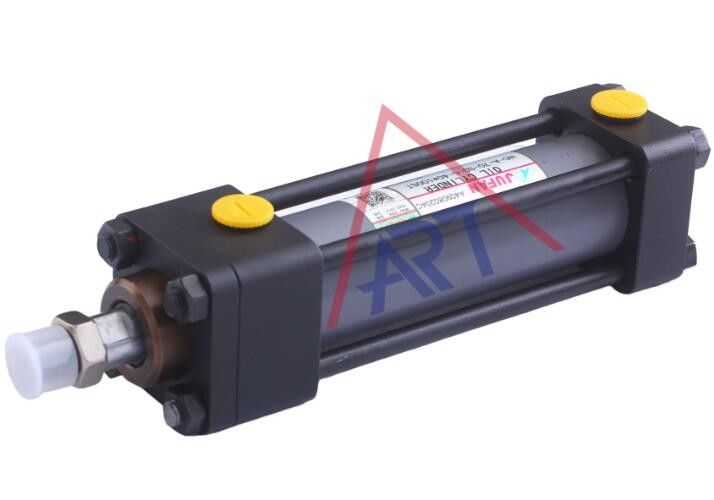Adjustment and Testing of Hydraulic Cylinder
First, reduce the working pressure inside the cylinder to around (0.5-1) MPa. Then, make the piston rod perform reciprocating motion and open the exhaust plug for exhaust.
The method of opening is as follows:
When the piston reaches the end of its stroke, open the exhaust plug at the moment when the pressure rises, and immediately close it before the return begins. During the exhaust process, you can hear a hissing sound, followed by the discharge of white and turbid foamy oil. When the air is completely discharged, the oil sprayed out will be clear. Exhaust completeness can be judged with the naked eye.
If the hydraulic cylinder is equipped with an adjustable buffering device, and the piston is in motion, first set the throttle valve to a position with a lower flow rate, and then gradually adjust the size of the throttle port until the requirements are met.
In addition to performing the above adjustment tasks, it is necessary to check for oil leakage in various sealing components and whether the bolts of the connecting parts are loose, in order to prevent accidents.
Based on the usage of the hydraulic cylinder, schedule regular inspection times and maintain inspection records.
-
Adjustment of Exhaust Device:
-
Adjustment of Buffering Device:
-
Inspection of Various Parts of the Hydraulic Cylinder:
-
Regular Inspection:
Alignment steps:
1.Turn lock nut towards counter clockwise with 1/4circle by wrench.
2.Using hex . wrench to adjust thealignment screw B:
1)clockwise, rod speed will be slow down
2)counter clockwise, rod speed will be up.
3.After alignment ,use hex. wrerch to fix thealignment screwB,and then tighten thecushion nut C to prevent possible
leakage from cushion seal D
4.Tighten the lock nut A
hydraulic cylinders can often be repaired if they are malfunctioning or damaged. The process typically involves several steps, and the specific repairs needed will depend on the type and extent of the issue. Here's an overview of the general process:
1. Diagnosis:
- Inspection: The first step is to thoroughly inspect the cylinder for signs of wear, damage, or malfunction. Common issues include leaks, bent or damaged rods, worn seals, or internal corrosion.
- Disassembly: If necessary, the cylinder is disassembled to inspect the internal components, including the piston, seals, rod, and barrel.
2. Repair or Replacement of Components:
- Seals and O-Rings: Worn or damaged seals are a common cause of leaks. Replacing these seals and O-rings is a common repair.
- Piston Rod: If the piston rod is bent, scratched, or damaged, it may need to be repaired or replaced. Minor scratches can sometimes be polished out, but severe damage may require a new rod.
- Barrel: If the barrel is damaged or corroded, it might need honing (a process that smooths the internal surface) or replacement if the damage is severe.
- Piston: The piston itself may also be inspected for wear or damage and repaired or replaced as needed.
3. Reassembly:
- After repairing or replacing the necessary components, the cylinder is carefully reassembled. Special attention is given to ensure all seals are correctly seated and that the components are aligned properly.
4. Testing:
- The repaired cylinder is tested to ensure it operates correctly under pressure. This includes checking for leaks, proper movement, and the ability to maintain pressure.
5. Reinstallation:
- Once tested and confirmed to be working correctly, the cylinder can be reinstalled in its application.
Can you fix a hydraulic cylinder?
Common Tools and Materials Needed:
- Wrenches, screwdrivers, and other basic hand tools.
- Seal kits specific to the hydraulic cylinder being repaired.
- Honing tools (if the barrel requires smoothing).
- Lubricants and hydraulic fluid.
When to Seek Professional Help:
- If the damage is extensive, or if you lack the necessary tools or expertise, it might be best to consult a professional hydraulic repair service. They can provide more advanced repairs, such as machining new parts or performing precision honing.
Repairing a hydraulic cylinder can restore its function and extend its lifespan, making it a cost-effective alternative to replacing the entire cylinder.
Port and cushion positions
| SD type |
LA type |
|

Standard=A:input port B:Cushion position D:Check valve position
|
 |
e.g:order form for position HCA70-LA-C-100X200-B-B-A
Input port=B position
Cushion=A position
Cushion length
 |
Bore(mm) |
L |
l |
| 32--63 |
20 |
10 |
| 80--160 |
25 |
15 |
| 180--224 |
30 |
27 |
| 250 |
35 |
32 |
- Should the movement of a cylinder with loading is above 500mm/sec.,
- If the moving speed is higher than 750mm/sec,external reducing speed valves should be used
The application not only for production mechanical machine tools and metal processing equipment, but also can be widely used in actuators of steel, nuclear power plant control, passenger elevators, etc
| Type |
Symbol |
Drawing |
With Bellow |
Heat Proof |
Bore(mm) |
 |

|
32,40,50,63,80,100,125,150,180,200,224,250 |
| Double acting |
HCA |
 |
HCA-H |
HCA-J |
| Double rod |
HCC |
 |
HCC-H |
HCC-J |
| Double rods with alignment |
HCD |
 |
HCD-H |
HCD-J |
HC2--A--70-- --SD--C--100--200ST-- -- -- -- -- --
1) 2) 3) 4) 5) 6) 7) 8) 9) 10) 11) 12) 13)
| HC2:Tie-Rod Hydraulic Cylinders |
| 1) Type |
A:doubling acting
C:double rods
D:double rods with stroke alignment
|
| 2)Working pressure |
70:70kgf/cm²
140:140kgf/cm²
|
| 3)Performance blank:(standardusage) |
H:with bellow
J:with heat/ erosion proof(the highest temperature is 200℃) |
| 4)Mounting type |
SD/FA/FB/CA/CB/LA/LB/TA/TC |
| 5)Rod size |
C: C class B:B class
note: 1standard:HC-70+C class rod
2.Standard:HC-140+B class rod
3. Please specify when HC-70+B class rod or HC-140+C class rod
|
| 6)Bore(mm) |
32,40,50,63,80,100,125,150,180,200,224,250 |
| 7)Stroke(mm) |
Max.stroke=Max length of stroke-Min. length of stroke |
| 8)Cushion blank: |
no cushion
B:Cushion on bothends
R: Cushion on rod cover
H:Cushion on head cover
|
| 9)Connectors Y |
Y :Yconnector
I:Iconnector
|
| 10)Stroke alignment |
only forward alignment and aligned length < or =stroke length
|
|
11)Port position
|
|
| 12)Cushion position |
|
| 13)Oil seal material blank |
NBR(standard usage),2: PU 3:FPM |
Specifying the needed material while ordering
(1)N:NBR
(2)V:F≤200℃
| Bore |
X |
| 32.40.50 |
1/3.5xstroke+45 |
| 63.80.100 |
1/4xstroke+55 |
| 125.150180.200 |
1/5xstroke+65 |
| 224.250 |
1/6xstroke+80 |
Factory:

What is hydraulic cylinder bore?
The bore of a hydraulic cylinder refers to the inner diameter of the cylinder barrel. It's the opening through which the piston moves back and forth inside the cylinder. The bore size is a critical parameter as it directly influences the force and speed of the hydraulic system.
In hydraulic cylinder specifications, the bore is often expressed in inches or millimeters. For example, if a hydraulic cylinder has a bore size of 2 inches, it means the inner diameter of the cylinder barrel is 2 inches.
Knowing the bore size is crucial for calculating the piston area, which, as we discussed earlier, is essential for determining the force exerted by the hydraulic cylinder.
FAQ
Q1: Are you a manufacturer or a trading company?
We have our own factory, so we can provide the best price as well the first service.
Q2: Do you accept customization or Non-standard products?
Yes, we can customize products as the customers required.
Q3: What is your MOQ?
MOQ depends on our clients needs. Besides, we welcome trial order before mass production.
Q4: How long is your delivery time?
Normally, the delivery time is 7 days if we have stock. If we don't have stock, it needs 15-30 working days. And it also depends on the quantity and requirements of products.
Q5: What are your payment terms?
T/T. If you have any questions, please feel free to contact us.

 Your message must be between 20-3,000 characters!
Your message must be between 20-3,000 characters! Please check your E-mail!
Please check your E-mail!  Your message must be between 20-3,000 characters!
Your message must be between 20-3,000 characters! Please check your E-mail!
Please check your E-mail! 

